Niagara
Square - Table of Contents
Buffalo
NY State Office Building /
Walter
J. Mahoney State Office Building (name since 1982)
65
Court
St., Buffalo, NY
| Erected: | 1928-1932 |
| Architects: | E B. Green & Son with Albert Hart Hopkins |
| Style: | Neoclassical
Monumental Art Deco ornamentation Stripped Classicism, Starved Classicism—or PWA Modern |
| Predecessor
building: |
Central High School |
| Walter Mahoney: | A local powerful state legislator who served nearly 30 years. He then became a State Supreme Court judge. He died in 1982 at the age of 78. |
Exterior Central High School 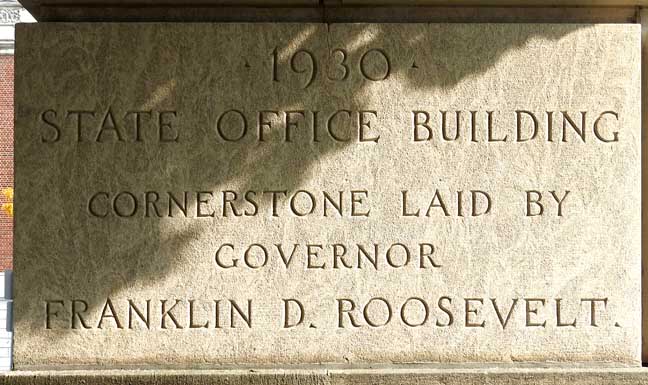  Right: McKinley Monument   Main entrance ... Four details below:  Detail #1 New York State motto: Excelsior, Latin for Ever Upward. The center shield displays a masted ship and a sloop on the Hudson River (symbols of inland and foreign commerce), bordered by a grassy shore and a mountain range in the background with the sun rising behind it. Liberty and Justice support the shield and an American eagle spreads its wings above on a world globe. Liberty's left foot treads on a crown (a symbol of freedom from the Kingdom of Great Britain). Justice is blindfolded and holds a sword in one hand and a scale in the other, symbolizing impartiality and fairness.  Detail #2 Liberty and Justice support the shield and an American eagle spreads its wings above on a world globe. Liberty's left foot treads on a crown (a symbol of freedom from the Kingdom of Great Britain). Justice is blindfolded and holds a sword in one hand and a scale in the other, symbolizing impartiality and fairness. 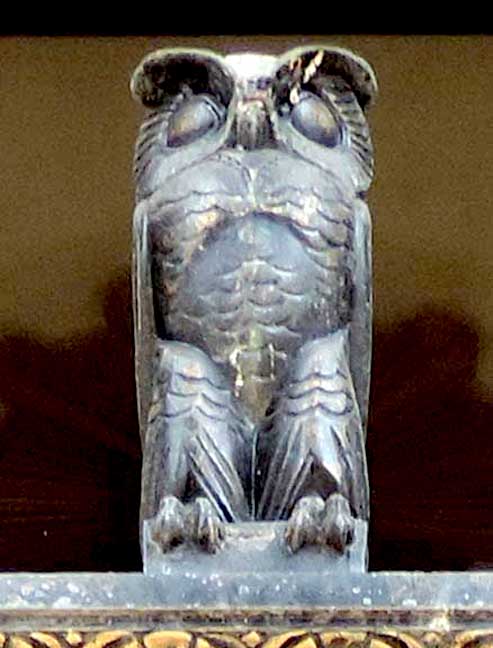 Detail #3 Owls symbolize wisdom 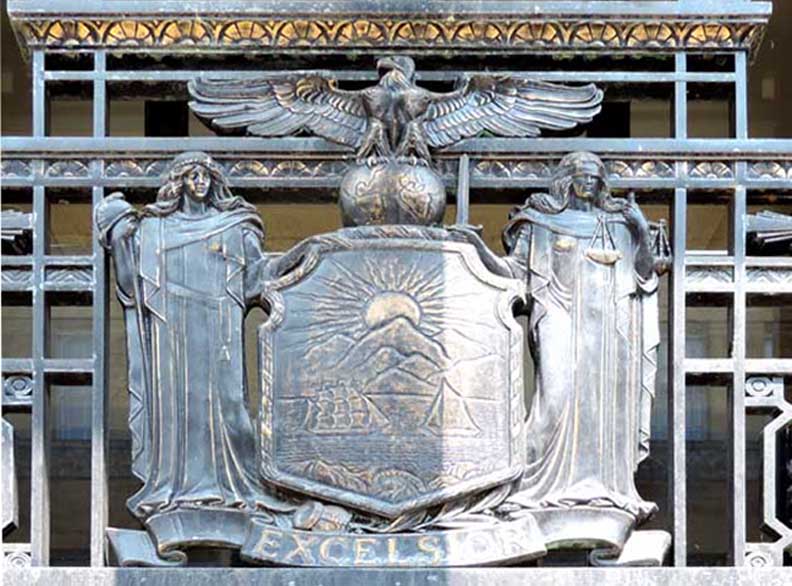 Detail #4 ... New York State Seal The center shield displays a masted ship and a sloop on the Hudson River (symbols of inland and foreign commerce), bordered by a grassy shore and a mountain range in the background with the sun rising behind it. Liberty and Justice support the shield and an American eagle spreads its wings above on a world globe. Liberty's left foot treads on a crown (a symbol of freedom from the Kingdom of Great Britain). Justice is blindfolded and holds a sword in one hand and a scale in the other, symbolizing impartiality and fairness.  New York State motto: Excelsior, Latin for Ever Upward. The center shield displays a masted ship and a sloop on the Hudson River (symbols of inland and foreign commerce), bordered by a grassy shore and a mountain range in the background with the sun rising behind it. Liberty and Justice support the shield and an American eagle spreads its wings above on a world globe. Liberty's left foot treads on a crown (a symbol of freedom from the Kingdom of Great Britain). Justice is blindfolded and holds a sword in one hand and a scale in the other, symbolizing impartiality and fairness.  1939 ordinance detailing the seal: “To the left center, lighthouse on pier; to the right of the lighthouse, ship with three (3) masts showing sails; to the lower right, canal boat drawn by two (2) draft animals proceeding in direction leading toward or past pier; the above, all, surrounded by a double circle and between said circles appearing the words ‘SEAL OF THE CITY OF BUFFALO.’  Bas-relief  Art Deco bas-relief ... Scallops near top ... Reeding at left .... Stylized volutes at right |
Lobby Walter J. Mahoney: A local powerful state legislator who served nearly 30 years. He then became a State Supreme Court judge. He died in 1982 at the age of 78.  Art Deco ornamentation ... Volutes and sunburst chevrons are prominent   Art Deco light fixture detailed below: 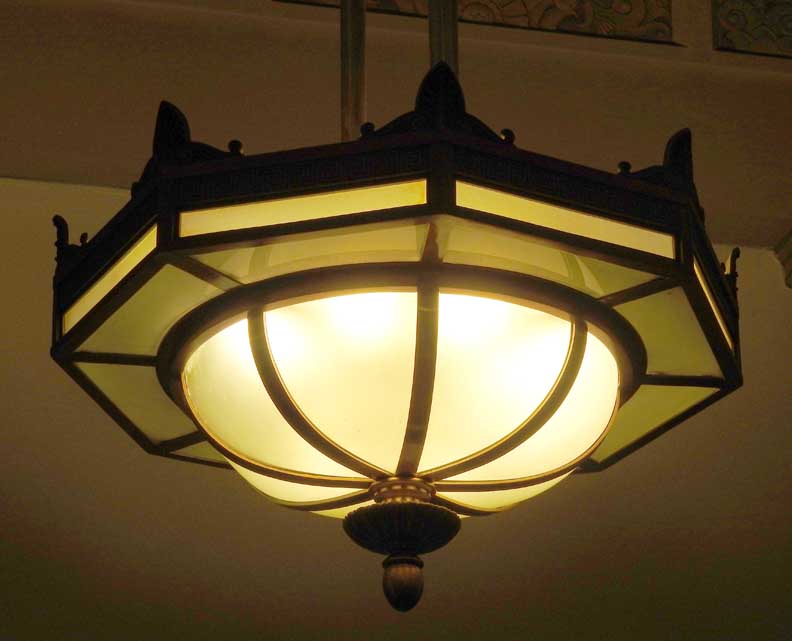  Ceiling mural ... Plaster rope molding ... Plaster panels featuring Art Deco stylized volutes and sunbursts  Cf., a similar cast aluminum table found across the street on Court St. in the Federal Office Building/Police and Fire Headquarters |
Three
Ceiling
Murals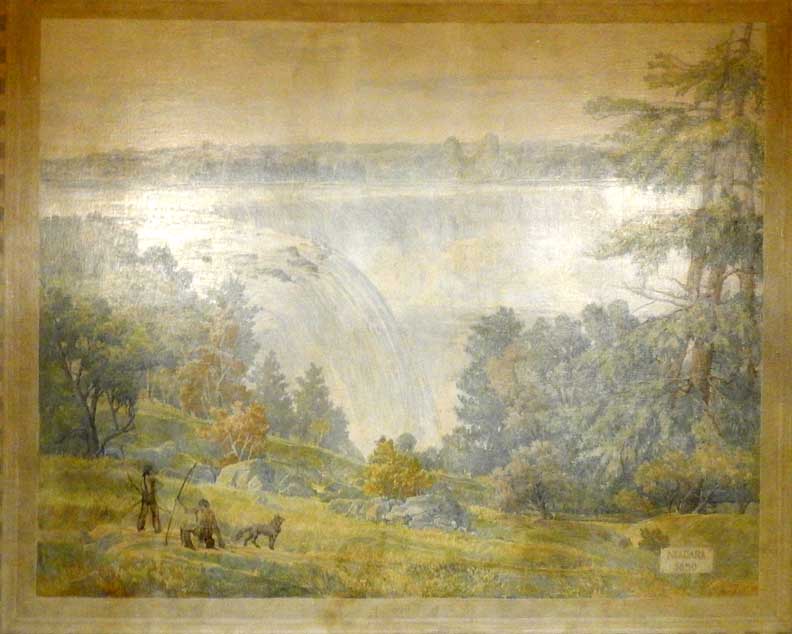 "Niagara 1680" ... Three details below:  "Niagara 1680" detail #1 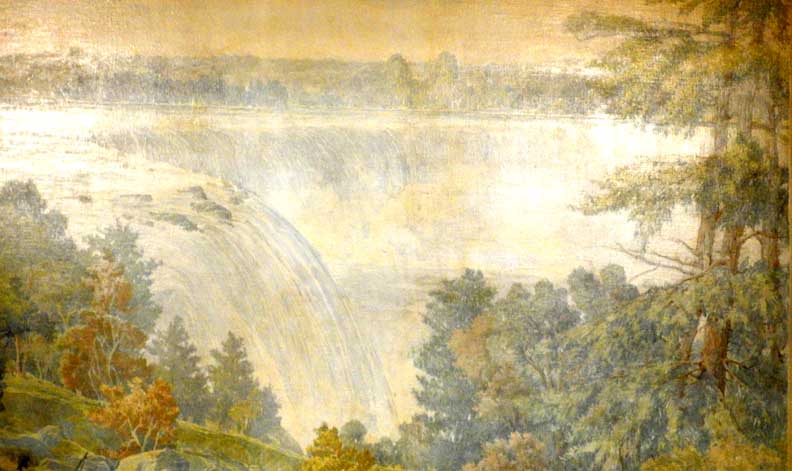 "Niagara 1680" detail #2 - Niagara Falls 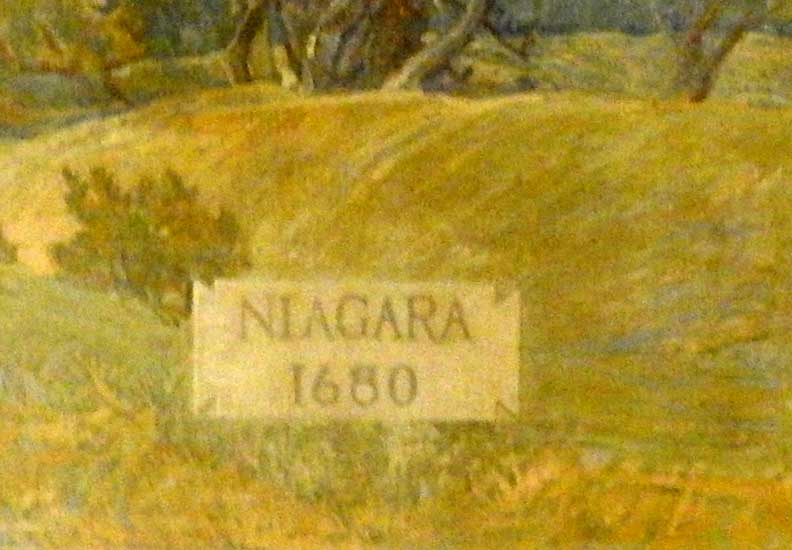 "Niagara 1680" detail #3  Ceiling mural: "Buffalo Harbor 1837" ... Detail below: 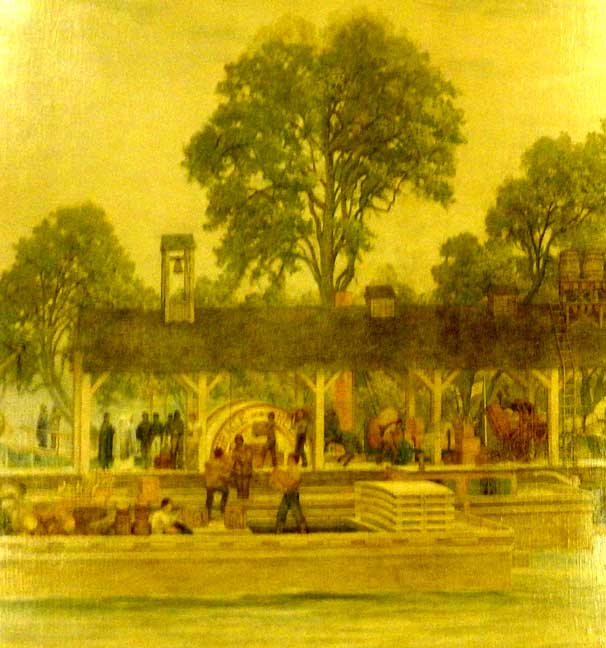 Detail - Ceiling mural: "Buffalo Harbor 1837" ... Barge 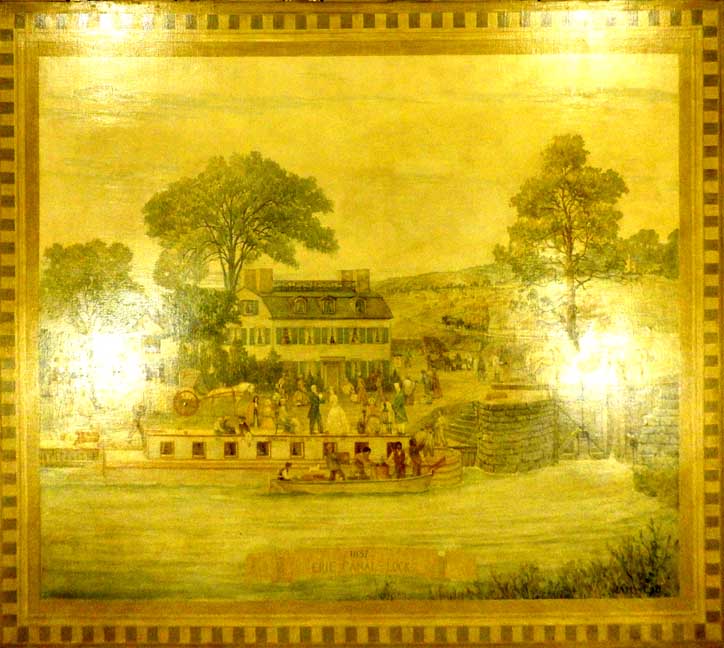 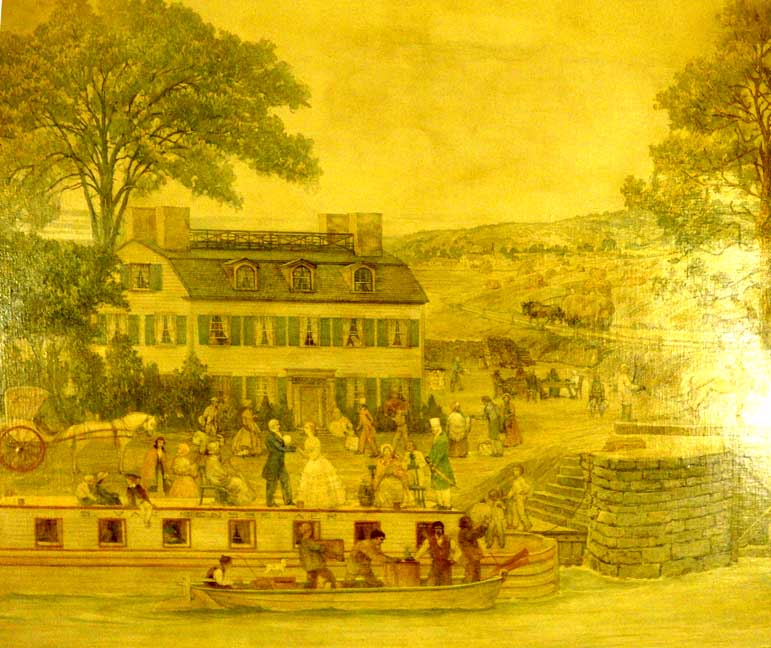 "Erie Canal Lock 1837" detail #1 ... Packet boat 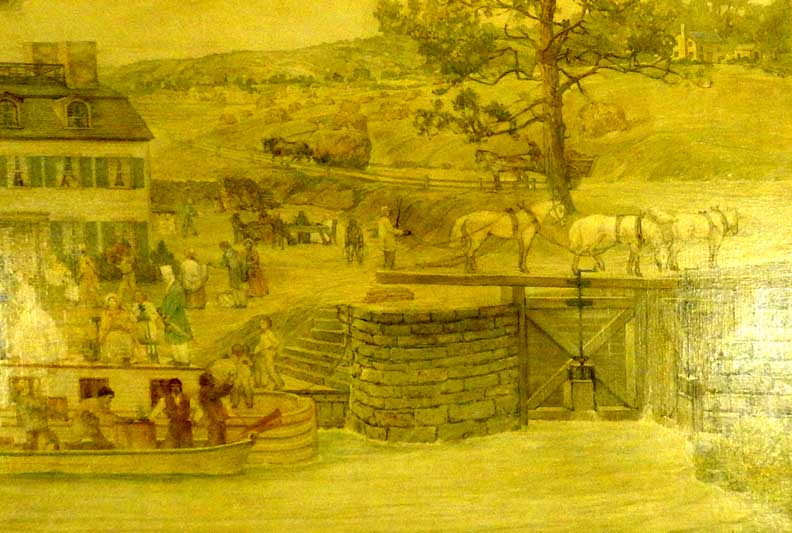 "Erie Canal Lock 1837" detail #2 ... Note lock at right ... Packet boat 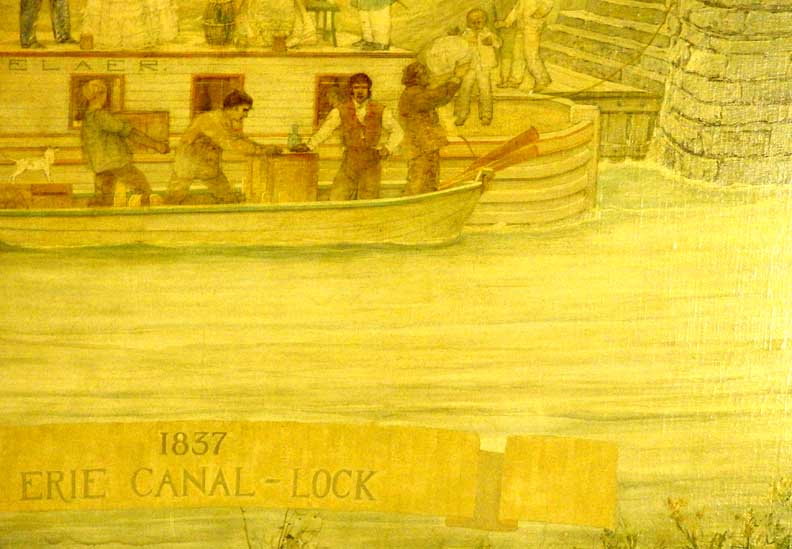 "Erie Canal Lock 1837" detail #3 ... Packet boat  "Erie Canal Lock 1837" detail #4 ... Artist's signature |
|
1930 The Keyes-Elliott Bill, an amendment to the Public Buildings Act of 1926, passes. The bill provides the secretary of the Treasury increased authority for entering into service contracts with private architects. The American Institute of Architects (AIA) begins a concerted lobbying effort for the Office of the Supervising Architect to reorganize as a management organization and cease its federal building design responsibilities. The AIA’s campaign is largely unsuccessful, as the government retains design responsibility for the smaller projects, awarding only larger commissions to private firms. Late 1920s-Early 1930s 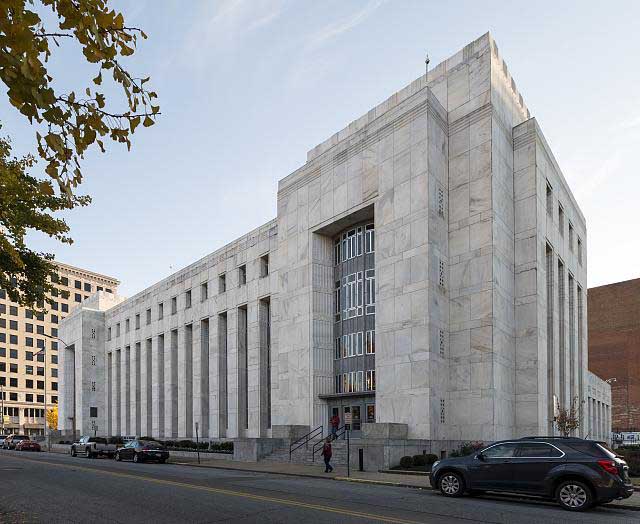 The Joel Solomon Federal Building and U.S. Courthouse, Chattanooga, Tennessee Photo credit: Carol M. Highsmith Private
sector
begins to embrace modern architectural ideals and new
building technologies. Examples include Rockefeller Center
(Associated Architects) in New York City and the
Philadelphia Savings Fund Society building (Howe and
Lescaze) in Philadelphia.
During the 1930s, the government embarks on a prolific construction program, and federal buildings throughout the country are planned and executed. Many buildings continue to reflect traditional styles, though they increasingly bear the influences of the early modern movement. Used primarily for government architecture, a new architectural style emerges that effectively straddles classicism and modernism. Simplified neoclassical forms are paired with the stylized designs of the Art Deco style. This new public building style is today alternately known as Stripped Classicism, Starved Classicism—or PWA Modern in recognition of the Public Works Administration that oversaw many such designs. |
